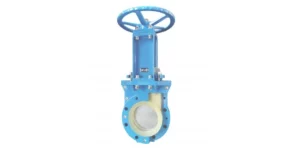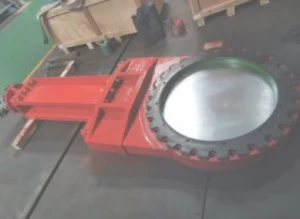Unveiling the Secrets of Knife Gate Valve Performance

Exploring the Basics of Knife Gate Valves
Introduction to Knife Gate Valves
In industrial applications where fluid flow needs to be controlled or shut off, knife gate valves are a fundamental feature. They are specially designed for applications that involve suspended solids or media with particulates, so they have applications in the mining industry, wastewater, and chemical processing industries. The knife gate valve compresses the design and is able to cut through all of the dense fluids and slurries while providing complete sealing to prevent leaking.
Key Components and Design Features
Material Considerations
Knife gate valve material has a high-quality environment for the work than like pipeline and corrosive alternatively very high temperature. These materials are carbon steel, stainless steel (AISI 304 or AISI 316), and cast iron. The material can vary with the application being specific to corrosion resistance, abrasion, high temperature, etc.
Structural Design Elements
A knife gate valve has a relatively uncomplicated design normally including one valve body, a gate, packing, gland follower, yoke, seat rings, and O-rings. The valve body can be made either by casting or fabrication, and it is used in bolted or welded form. The gate is typically polished on both sides to prevent jamming and damage to the seat. Seals are sometimes also replaceable rubber from a sealed container or PTFE-impregnated packing for a better seal.
Common Applications in Industry
Designed to handle a variety of applications, Knife gate valves can be employed in several industries. Typical applications include abrasive slurries in the mining industry, high-pressure steam flow control in power plants, corrosive fluids in chemical plants, and effluent discharge regulation within wastewater treatment. Also, their high concentration handling capacity makes them irreplaceable in the pulp and paper industries.
Factors Influencing the Performance of Knife Gate Valves
|
Factor |
Description |
|
Fluid Dynamics |
The flow characteristics such as velocity, pressure drop, and turbulence can impact valve performance by affecting the sealing efficiency and wear rate of the components. |
|
Operational Conditions |
Temperature extremes, pressure variations, and the presence of corrosive or abrasive media can influence the valve’s longevity and reliability. Regular monitoring is essential to ensure optimal operation under varying conditions. |
Maintenance and Troubleshooting for Optimal Performance
Routine Inspection Protocols
For a knife gate valve, a proper schedule to maintain it to perform its best. Routine inspections should check for worn components to the gate, seat rings, packing glands, and seals. This maintenance procedure consists of lubrication of moving parts and tightening of bolts at regular intervals, ensuring that the unit is operated properly.
Addressing Common Issues
Leaking stem seals or packing material degradation are typical problems with a knife gate valve. Fast replacement of defective parts will limit other issues. Correct alignment during installation prevents misalignment that could cause inefficiency or even failure to operate. Correct alignment at the time of installation can help eliminate misalignment-related problems that can give rise to poor operational efficiency.
With this knowledge about knife gate valve performance —from material to maintenance—industry experts can optimize their use in different applications and minimize system downtime by extending service life! It explores improving the life of knife gate valves explained from material choice to maintaining aspects that can maximize use in different industries with less downtime.
Enhancing Efficiency Through Technological Innovations

Advances in Valve Materials
Over the years, materials used in knife gate valves have developed to a point that allows them to perform at utmost efficiency. Modern innovations have also brought alloys and composite materials that last considerably longer under corrosive or erosive, high-temperature circumstances of use than their more conventional predecessors. Not only are these materials more resilient but also they tend to be lighter, which makes handling and installation easier. That also enables valve manufacturers to specialize in the anti-corrosion material for a specific industrial application thereby increasing service life and minimizing future maintenance requirements.
Automation and Smart Technology Integration
With the automation and smart technology knife gate valves connecting to them, by going through innovations have changed the functions of knife gate valves within these components that actually work in industries. Remote monitoring and control functionality offered by automated knife gate valves enables accurate adjustments to flow rates and pressure levels without the need for human involvement The valve system contains embedded smart sensors that provide real-time information regarding the status of the valve such as level of wear and defect detection facilitating predictive maintenance techniques to reduce downtime. This development maintains the high operational efficiency of knife gate valves while minimizing their running costs.
Looking Ahead: Future Trends and Developments in Valve Technology
Emerging Technologies in Valve Design
Exciting developments are on the horizon for knife gate valve technology, as there are several emerging technologies that focus on improving performance and sustainability. Even more valve innovations aimed at improving valve reliability include mechanisms that keep valves free from sediment build-up or other debris. Also, 3D printing technology can continue to develop and be able to make valve designs based on certain applications that will optimize the flow characteristics of this type of part which greatly minimizes losses so as not to waste material.
Miwival’s Role in Advancing Valve Solutions
Overview of Miwival’s Knife Gate Valves
Miwival has been leading the way in knife gate valve development, carrying a wide selection of products suitable for many different industrial uses. These valves have been built with a sturdy double-seated design and provide reliable shut-off under demanding conditions. To ensure high durability and corrosion resistance, Miwival used best-grade materials such as stainless steel and carbon steel.
Introduction to Other Miwival Products, such as Ball Valves
Miwival not only offers its well-known knife gate valves but also an entire variety of valve solutions including ball valves. These are used for precise regulating mechanisms of fluid flow within different industries. Miwival’s ball valves are compact, easy to operate, and reliable sealing. These are available in a wide array of materials that can be used for various media conditions and commonly serve applications needing fast shut-off capabilities.
Miwival contributes to the worldwide evolution and modernization of valve technology in each industry by continuing to innovate and diversify its range of products. With their commitment to quality and performance, they continue to be a leading partner for companies requiring fluid control solutions that are both reliable and efficient.
Overall, all aspects of the knife gate valve performance from material to high tech allow professionals to fully comprehend and determine what option is more suitable for their operation. But with new trends and constant developments from companies such as Miwival, this important part of industrial processes can only become more trustworthy in the future.





